Nickel fluoride (NiF₂) is an inorganic compound belonging to the class of nickel halides. It is a crystalline solid, typically appearing as a greenish-yellow powder or solid at room temperature. Its structure consists of nickel cations (Ni²⁺) and fluoride anions (F⁻), forming a lattice with a high melting point and stability under standard conditions.Chemical Properties Nickel fluoride is most commonly encountered in its anhydrous form but can also exist as hydrated forms, such as NiF₂·4H₂O. It is insoluble in most organic solvents but soluble in water, producing a slightly acidic solution due to partial hydrolysis. As a transition metal compound, it exhibits paramagnetic properties. Nickel fluoride is also known for its strong oxidative properties, making it reactive in specific chemical environments. Applications Nickel fluoride finds use in various industrial and scientific domains. Catalysis: Its oxidative characteristics make it an effective catalyst in chemical reactions, particularly in organic synthesis and fluorination processes. Battery Technology: Nickel fluoride has potential applications in battery systems, including nickel-based rechargeable batteries, where its electrochemical stability is advantageous. Material Science: It is employed in the synthesis of advanced materials, including ceramics and coatings, offering thermal and chemical resistance. Analytical Chemistry: In laboratory settings, nickel fluoride can serve as a reagent in the preparation of other nickel compounds or fluoride-containing materials. Health and Safety Considerations While nickel fluoride has significant industrial utility, it must be handled with care due to its toxicity. Exposure to nickel fluoride can cause respiratory issues, skin irritation, and other health problems. Prolonged exposure may pose a risk of systemic effects, including nickel-related allergies and chronic conditions. Proper safety measures, such as the use of personal protective equipment and adherence to occupational safety guidelines, are essential when working with this compound. Conclusion Nickel fluoride is a chemically and industrially significant compound with diverse applications ranging from catalysis to material science. Despite its utility, its handling demands caution due to health and safety concerns. As research continues, nickel fluoride’s role in innovative technologies, such as energy storage and advanced materials, is expected to expand.
Nickel Fluoride
| Cas No : | 10028-18-9 |
| Formula : | F2Ni |
| Hsn Code : | 28261990 |
| Form : | Power |
| Molecular Weight : | 96.69 g/mol |






Reviews
There are no reviews yet.